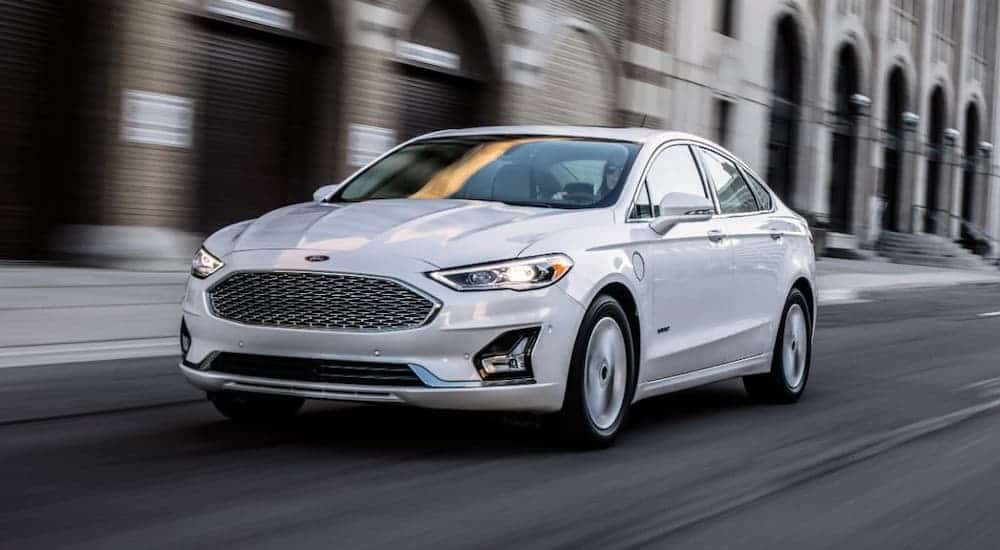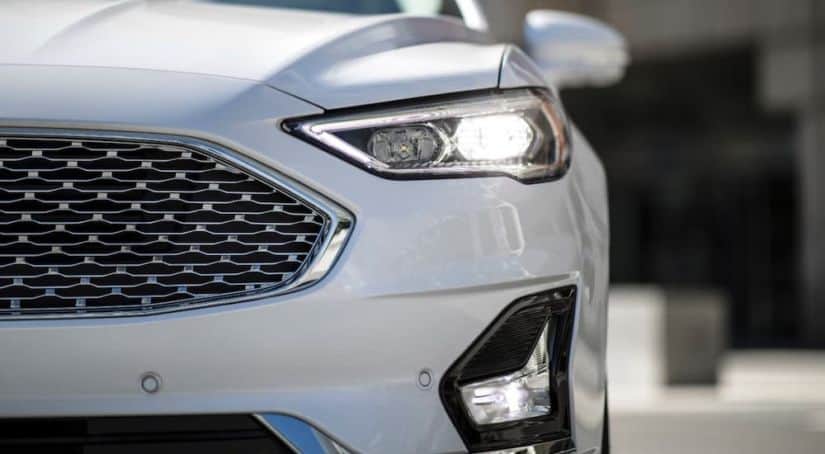Comparing the 2020 Ford Fusion vs 2021 Toyota Camry reveals some interesting results. They may both be midsize sedans, but they are built with somewhat different mindsets. The Fusion is the last Ford midsize sedan and features modern technologies such as lightweight small-displacement turbocharged engines. Meanwhile, the Toyota Camry has less sophisticated ways of getting things done, like its large naturally aspirated engines. New most certainly does not always mean improved, but the Ford Fusion, by and large, does stand out above other sedans, even the well established and popular Camry. Let’s go through each aspect of what makes these cars what they are.
Contrasting Interior Choices
The most important aspect of any midsize car is the interior. Mostly in terms of passenger space, comfort, and amenities, but also style. While the Camry’s interior is busy and flamboyant, the Fusion offers an understated and to the point professionalism. In lieu of the Camry’s overlapping and crisscrossing lines, the Fusion’s interior presents a clean and straightforward aesthetic with crisp black lines accented by silver.
In terms of interior technologies and amenities, the Fusion and Camry are actually quite similar. Both vehicles are compatible with Android Auto and Apple CarPlay. Both come with large touchscreens, with the Camry having a 7-inch screen standard while the Fusion has an available 8-inch capacitive touchscreen unit. Both vehicles also feature hands-free controls, the Fusion’s, in particular, being well-integrated with SYNC 3 communications and entertainment system.
The similarities between the two car’s amenities continue with the Camry offering an impressive 9-speaker audio setup as an optional upgrade while the Fusion has an available 12 speaker Sony audio system. Overall, the two vehicles tend to be close in the interior technology department. That said, the Fusion often carries a slight edge, especially in the higher trim levels more commonly purchased by consumers.
In terms of actual interior space and comfort, however, there is a larger difference between these two vehicles. The Fusion has noticeably more front-seat headroom, legroom, and shoulder room than the Camry. Tall drivers will find life much more agreeable in the Fusion. The same is largely true of the rear as well, where the Fusion offers more legroom and shoulder room than the Camry does. Overall, the Fusion is better engineered to make use of the vehicle’s total dimensions, giving it more space in most important individual categories as well as more interior volume in general.
That theme is carried into the Fusion’s trunk, which at a surprisingly large 16 cubic feet is noticeably larger than the Camry’s 15 cubic foot trunk. While the Camry may nearly match the Fusion in terms of interior amenities and technology, it is rather soundly beaten in terms of interior comfort and space.

Modern Safety Systems
In terms of safety considerations, both the Fusion and Camry are excellent. The Camry features its Toyota Safety Sense 2.5+ suite of driver aids, while the Fusion makes use of the Ford Co-Pilot360 suite. Co-Pilot360 is an array of systems and sensors that keep a watchful eye on the Fusion’s surroundings at all times, including areas that are challenging or impossible for the driver to keep track of. Co-Pilot360 and the Toyota Safety Sense 2.5+ are both standard features on their respective cars and provide many of the same overall safety capabilities.
These include backup cameras, which give a driver a clear view of what is directly behind the rear bumper, and automatic emergency braking, which can stop the vehicle almost instantly when a pedestrian or other obstruction is detected. Lane-keeping assist is another standard feature, which helps keep the vehicle in its lane on long drives and alerts the driver when unintentional lane departure is about to occur. However, only the Fusion comes standard with blind spot detection, which monitors the blind spots of the vehicle and alerts the driver when something is present there. With the Camry, this important feature is only an added option.
Drivetrain Differences
The technological differences between the Fusion and Camry are most pronounced under the hood. The Fusion is available with cutting edge turbocharged engines that provide good power out of small, efficient displacements. Meanwhile, the Camry has large engines that lack forced induction.
The turbocharged EcoBoost engines used on the Fusion also produce more torque than their Toyota counterparts. This is the statistic that really makes a vehicle feel powerful, allowing Ecoboost-equipped Fusions to leap away from a standing start. Comparatively, the Camry’s engines require more time to wind up. This is even true of the large 3.5-liter V6 that forms the top of the Camry line. Only installed in the most well-appointed Camry models, the 2GR-FE engine is one of Toyota’s best, yet despite its power and poise, it has noticeably less torque than the twin-scroll turbocharged 2.0-liter EcoBoost available in the Fusion.
In terms of maximum efficiency, the Camry’s older technology continues to let it down. The purely gasoline-powered versions of the 2021 Camry actually acquit themselves very well, with truly impressive MPG figures. But the Fusion has a plug-in hybrid variant that in many ways leapfrogs the entire Camry lineup.
The main advantage a plug-in hybrid has is that it can travel on battery power alone for extended distances. In the case of the 2020 Fusion, the plug-in hybrid has an electric range of 26 miles. This means that for every in-city commute, every around-town trip, and every trek to school and back across town, the Fusion Energi doesn’t need gasoline at all. Practically speaking, an owner of a plug-in hybrid Fusion would only ever need to use gasoline on road trips.
The EPA has attempted to average out this lack of gasoline usage into a 103 MPGe fuel economy rating. While that number sounds crazy, it is the best attempt one can put forward to apply internal combustion engine logic to what is mostly an electric vehicle. Electric is the future in more ways than one, and just one of those ways is that it is exponentially more efficient.

Solid Chassis Design
While the Fusion does have more interior space and more advanced propulsion systems, in terms of the two vehicle’s underpinnings, they are largely similar. Both vehicles are mostly made of high-strength steel, though the Fusion does include an aluminum hood to reduce weight and improve weight balance. Both the Fusion and Camry use a MacPherson Strut setup for their front suspension, which allows for good overall body control as well as compact packaging. However, Camrys equipped with either the large V6 engine or all-wheel drive take a penalty in terms of their turning circle. This is due to the size of the components, which is more obstructive compared to the Fusion’s compact turbocharged engines and driveline.
Ford’s Best Sedan
The 2020 Ford Fusion and 2021 Toyota Camry seem quite similar at first glance, and in some ways, they are throughout. That said when it comes to drivetrain technology, interior space, and overall comfort, the Fusion is markedly better. In most other ways, the Fusion still remains a step ahead, notably in interior technology and chassis optimization. The Fusion has a roomier interior, a plug-in hybrid variant, and turbocharged torque on many engine options. The Camry is a great mid-sized car with a daring interior design and a powerful V6 engine option, but the Fusion is simply the more advanced design.



